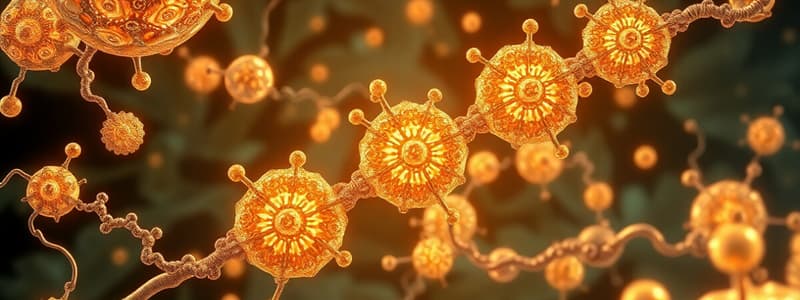Podcast
Questions and Answers
What is the primary role of enzymes in chemical reactions?
What is the primary role of enzymes in chemical reactions?
- They increase the activation energy needed for reactions.
- They lower the activation energy necessary for reactions. (correct)
- They permanently change the substrates.
- They provide energy for reactions.
How do enzymes typically interact with their substrates?
How do enzymes typically interact with their substrates?
- Substrates change shape to fit any enzyme.
- The shape of the substrate fits into the enzyme’s active site. (correct)
- Enzymes only work in one specific temperature.
- One enzyme can interact with multiple different substrates.
What is a possible effect of a competitive inhibitor on enzyme activity?
What is a possible effect of a competitive inhibitor on enzyme activity?
- It deforms the enzyme's structure.
- It increases the activation energy required.
- It enhances the enzyme's catalytic ability.
- It blocks the active site of the enzyme. (correct)
What characterizes allosteric enzymes?
What characterizes allosteric enzymes?
What factor does NOT influence enzyme activity?
What factor does NOT influence enzyme activity?
What happens during feedback inhibition?
What happens during feedback inhibition?
Which statement about enzyme cofactors is true?
Which statement about enzyme cofactors is true?
Enzymes are described as what type of molecules in relation to the reactions they assist?
Enzymes are described as what type of molecules in relation to the reactions they assist?
What is the rate-limiting reaction in the mevalonate pathway?
What is the rate-limiting reaction in the mevalonate pathway?
Which form of energy is primarily involved in photosynthesis?
Which form of energy is primarily involved in photosynthesis?
What does the First Law of Thermodynamics state?
What does the First Law of Thermodynamics state?
Which statement about kinetic energy is true?
Which statement about kinetic energy is true?
What effect does increasing entropy have on biological order?
What effect does increasing entropy have on biological order?
Why are statins used in relation to the mevalonate pathway?
Why are statins used in relation to the mevalonate pathway?
What is Gibbs free energy (G) characterized as?
What is Gibbs free energy (G) characterized as?
Which of the following is a common misconception regarding energy transformation?
Which of the following is a common misconception regarding energy transformation?
What does a negative ΔG indicate about a chemical reaction?
What does a negative ΔG indicate about a chemical reaction?
Which of the following represents an endergonic reaction?
Which of the following represents an endergonic reaction?
Why are reactions that reach equilibrium not desirable for living organisms?
Why are reactions that reach equilibrium not desirable for living organisms?
What is the metabolic steady state?
What is the metabolic steady state?
During cellular respiration, the free energy released from glucose is primarily used to:
During cellular respiration, the free energy released from glucose is primarily used to:
Which statement is true about exergonic reactions?
Which statement is true about exergonic reactions?
What is the total change in free energy (ΔG) for the complete metabolism of 1 mole of glucose during cellular respiration?
What is the total change in free energy (ΔG) for the complete metabolism of 1 mole of glucose during cellular respiration?
In the equation ΔG = GFinal – GInitial, what does a positive ΔG indicate?
In the equation ΔG = GFinal – GInitial, what does a positive ΔG indicate?
Flashcards are hidden until you start studying
Study Notes
Enzymes and Energetics
- Enzymes are biological catalysts that accelerate chemical reactions by lowering the activation energy (Ea).
- Enzymes achieve this by aligning substrate functional groups, stretching substrate bonds, and creating microenvironments.
- The rate of enzymatic reactions depends on the substrate concentration and the availability of enzyme active sites.
- Enzymes require cofactors (e.g., ions) and coenzymes (e.g., NAD+) for optimal activity.
- Enzyme activity is influenced by environmental factors such as temperature, pH, and salinity.
- Enzymes can be inhibited by competitive inhibitors (block active site) and non-competitive inhibitors (deform active site).
- Inhibition can be irreversible or reversible.
Enzyme Affinities and Cycles
- Enzymes exhibit specificity for substrates due to the complementary shape between the substrate and the enzyme's active site.
- Enzyme-substrate complexes undergo conformational changes during catalysis, resulting in product formation.
- A single enzyme molecule can catalyze multiple cycles of the same reaction without being destroyed.
Activators and Inhibitors
- Allosteric activators stabilize the active form of allosteric enzymes, while allosteric inhibitors stabilize the inactive form.
- Feedback inhibitors regulate biochemical pathways by inhibiting enzymes involved in earlier steps, often through reversible non-competitive inhibition.
Biochemical Pathways
- Biochemical pathways consist of a series of linked chemical reactions where the product of one reaction serves as the reactant for the next.
- The rate-limiting reaction in a pathway is the slowest step, often targeted by pharmaceuticals to modify pathway activity.
Basics about Energy
- Energy is the capacity to perform work. It can be stored (potential energy) or actively doing work (kinetic energy).
- Energy exists in different forms: solar, electrical, mechanical, chemical, and heat.
- Chemical energy is stored within chemical bonds and can be transferred when bonds break.
- Solar energy has a higher potential to perform work than heat.
Thermodynamic Laws
- Thermodynamics studies energy transfer and transformation.
- The First Law states that energy cannot be created or destroyed, only transferred and transformed.
- Photosynthesis transforms solar energy into chemical energy, while cellular respiration converts chemical energy into ATP.
- ATP powers various biological processes.
- Energy transformations are not 100% efficient, resulting in heat production.
- The Second Law states that energy transfer during transformation increases the entropy (disorder) of the universe.
- Biological systems require energy to maintain order and fight against entropy.
Who Says Energy is Free? (Gibbs Energy)
- Free energy (G) is the energy available to perform work.
- Change in free energy (ΔG) indicates energy released (exergonic, negative ΔG) or required (endergonic, positive ΔG).
- Exergonic reactions are spontaneous as reactants have more free energy than products.
- Endergonic reactions are non-spontaneous as products have more free energy than reactants.
Cells Transform Energy
- Photosynthesis is an endergonic process requiring solar energy to synthesize glucose.
- Cellular respiration is an exergonic process that releases energy from glucose into ATP and heat.
Don’t Equilibrate to Live
- Many chemical reactions are reversible and reach equilibrium where ΔG is zero, resulting in no free energy for work.
- Biota must maintain a negative ΔG to perform work and survive.
- The metabolic steady state describes the ongoing process of maintaining a negative ΔG.
Studying That Suits You
Use AI to generate personalized quizzes and flashcards to suit your learning preferences.





